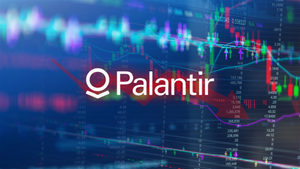
As November 2025 unfolds, the fervent optimism surrounding Artificial Intelligence (AI) stocks is increasingly being tempered by a growing wave of apprehension regarding their sky-high valuations. This complex sentiment is casting a long shadow over the broader stock market, triggering recent pullbacks and prompting a cautious reassessment among investors. The spectacular rise of AI-driven companies, which has fueled significant market gains, is now facing critical examination, with many analysts drawing uncomfortable parallels to past speculative bubbles.
The immediate implications of this shift are palpable, marked by increased market volatility and a noticeable pivot towards risk aversion. High-flying AI bellwethers, once seemingly impervious to doubt, are now experiencing significant corrections. A prime example is Palantir Technologies (NYSE: PLTR), whose shares slid by more than 6-7% in premarket and after-hours trading despite reporting strong earnings and raising its annual revenue outlook. This "sell-on-the-news" reaction for a company often seen as an AI leader signals a significant change in investor appetite and a broader market recalibration.
The AI Gold Rush Meets Valuation Reality
The current market dynamic is characterized by a stark contrast between the transformative potential of AI technology and the financial metrics used to justify the valuations of companies spearheading this revolution. Investors are grappling with several core concerns that are collectively contributing to the broader market's cautious stance. Many AI stocks are trading at what some consider unsustainable premiums, with price-to-earnings (P/E) and price-to-sales ratios reaching levels reminiscent of the dot-com era. For instance, Palantir Technologies, despite its robust performance, has faced scrutiny for its premium valuation, boasting a price-to-sales ratio that has raised eyebrows among market watchers. Notorious investor Michael Burry, famed for predicting the 2008 housing crisis, has notably expressed bearish views on the sector, reportedly taking substantial put options against prominent AI companies like Nvidia (NASDAQ: NVDA) and Palantir.
A significant driver of this valuation concern is the massive capital expenditure (Capex) planned by Big Tech firms. Trillions are projected to be invested in AI infrastructure over the next five years, with an estimated $400 billion allocated for 2025 alone. While these investments are crucial for technological advancement, historical precedents suggest that such infrastructure booms can lead to overinvestment, intense competition, and ultimately, suboptimal returns for the infrastructure builders themselves. Questions are mounting about whether these colossal investments will translate into proportional, sustainable returns, especially as reports indicate that many generative AI business initiatives are still in experimental phases or yielding limited immediate returns.
The AI-fueled rally has also created a market heavily concentrated in a select few "Magnificent Seven" tech giants, including Alphabet (NASDAQ: GOOGL), Amazon (NASDAQ: AMZN), Apple (NASDAQ: AAPL), Meta Platforms (NASDAQ: META), Microsoft (NASDAQ: MSFT), Nvidia (NASDAQ: NVDA), and Tesla (NASDAQ: TSLA). This narrow market breadth means that the overall market's performance is disproportionately reliant on these companies, making it highly vulnerable to their individual fortunes or any sector-specific downturns. The appearance of the "Hindenburg Omen," a technical indicator often preceding significant market corrections, multiple times in late October and early November 2025, has further amplified investor anxiety, suggesting that the current rally might be losing its underlying strength.
Companies Navigating the AI Valuation Tightrope
The re-evaluation of AI stock valuations will inevitably create distinct winners and losers within the market. Companies with robust fundamentals, proven profitability, and clear pathways to monetizing their AI innovations are better positioned to weather the storm, while those with speculative business models and inflated valuations may face significant headwinds.
Potential Losers: Companies whose stock prices have soared primarily on the promise of future AI revenue, without a solid track record of profitability or diversified income streams, are particularly vulnerable. Many early-stage AI startups, despite commanding exceptionally high valuations, often have limited revenue and unproven business models. As investor sentiment shifts towards caution and a demand for tangible returns, these companies could see sharp corrections. Even established players like Palantir (NYSE: PLTR), despite delivering strong results, experienced a post-earnings slide, highlighting that even good news might not be enough to sustain what the market perceives as an overstretched valuation. The market is increasingly scrutinizing the sustainability of growth and profitability for all AI-related ventures, pushing investors away from pure speculation.
Potential Winners: Conversely, companies that can demonstrate clear, measurable returns on their AI investments and possess diversified revenue streams are likely to be more resilient. The "Magnificent Seven" tech giants, while contributing to market concentration, often have established businesses that generate significant cash flow, allowing them to absorb AI development costs more effectively. Companies providing essential AI infrastructure, such as semiconductor manufacturers like Nvidia (NASDAQ: NVDA), or cloud service providers that enable AI development, may continue to see demand, but even their valuations will come under stricter scrutiny. Furthermore, companies that leverage AI to enhance existing, profitable operations, rather than relying solely on AI as their core product, could be seen as safer bets. The focus will shift from "AI potential" to "AI-driven profitability."
Wider Significance: Echoes of Past Bubbles and Future Regulations
The current concerns over AI valuations are not isolated events but rather fit into broader industry trends and economic narratives. The parallels drawn to the dot-com bubble of the late 1990s are becoming increasingly frequent, with analysts warning that even if AI proves to be as revolutionary as the internet, the initial wave of investors in infrastructure and speculative ventures may still face significant losses. This historical context underscores the idea that transformative technology doesn't always translate into immediate or sustained stock market success for all participants.
The ripple effects of an AI valuation correction could be substantial. Competitors within the AI space might find it harder to raise capital at previous valuations, leading to consolidation or a slowdown in innovation for smaller players. Partners relying on the financial health of highly valued AI companies could also feel the pinch. Beyond the immediate market, there's a growing discussion about the broader economic impact. While AI has been a primary driver of economic growth in the first half of 2025, contributing significantly to GDP growth and S&P 500 returns, a slowdown in this sector could expose underlying weaknesses in the broader economy, particularly if AI-related job cuts continue to impact the labor market.
Regulatory and policy implications, while not directly causing valuation concerns, could emerge as a response to the rapid, unchecked growth of the AI sector. Governments worldwide are already exploring frameworks for AI ethics, governance, and competition. A market correction could intensify calls for greater oversight, particularly if the perceived risks of AI's economic dominance or job displacement become more pronounced. Historically, periods of market exuberance followed by sharp corrections often lead to increased regulatory scrutiny and attempts to prevent future speculative excesses.
What Comes Next: Navigating a More Discerning Market
The path forward for AI stocks and the broader market is likely to be characterized by heightened scrutiny and a more discerning investment approach. In the short term, increased volatility is almost a certainty. Corporate earnings reports from AI leaders will be closely watched, with any signs of slowing growth, margin pressure, or further valuation warnings potentially triggering sharp market reactions. Investors should anticipate continued "sell-on-the-news" events, even for companies delivering strong performance, as the market prioritizes sustainable profitability over growth at any cost.
In the long term, the AI revolution will undoubtedly continue, but the investment landscape will likely mature. This could necessitate strategic pivots for many AI companies, shifting focus from aggressive growth and market share acquisition to demonstrating clear paths to profitability and efficient capital allocation. Companies that can articulate and execute a strategy for monetizing AI beyond mere technological prowess will gain favor. This period might also present significant market opportunities for astute investors. Undervalued companies with strong underlying AI technology, but whose stock prices have been unfairly dragged down by broader sector corrections, could become attractive long-term plays.
Potential scenarios range from a soft landing, where AI valuations gradually normalize without a catastrophic market crash, to a more severe correction if investor confidence truly erodes. The key will be how quickly companies adapt to the new market realities and how effectively they can translate their AI innovations into tangible, sustainable economic value. The market will reward discipline, clear financial metrics, and a focus on real-world applications that generate measurable returns.
Comprehensive Wrap-up: A Maturing AI Investment Landscape
The current concerns surrounding AI valuations represent a critical juncture for the financial markets, marking a transition from unbridled enthusiasm to a more sober assessment of the sector's long-term sustainability. The key takeaway is that while AI remains a profoundly transformative technology, the investment environment is maturing, demanding greater financial discipline and demonstrable profitability from AI-focused companies. The recent market pullbacks, exemplified by the performance of companies like Palantir, serve as a potent reminder that even groundbreaking technology is not immune to the fundamental laws of valuation.
Moving forward, the market will likely continue to exhibit a degree of concentration, but with an increased emphasis on the financial health and proven business models of the leading AI players. Investors should closely monitor capital expenditure discipline, corporate earnings, and any shifts in regulatory sentiment. Diversification will be crucial, as will a careful assessment of individual company fundamentals rather than simply riding the AI wave. The lasting impact of this period will likely be a more rational and sustainable approach to investing in AI, distinguishing between speculative hype and genuine, value-creating innovation. The coming months will reveal which companies can truly harness AI's power to generate long-term shareholder value, and which were merely beneficiaries of a fleeting speculative frenzy.
This content is intended for informational purposes only and is not financial advice






